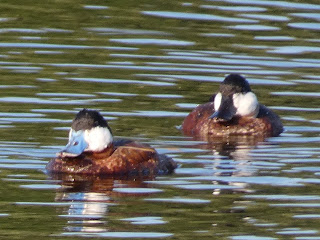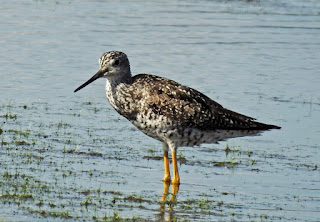NATURE
MONCTON INFORMATION LINE, Aug. 10, 2020 (Monday)
Please advise editor at nelsonpoirier435@gmail.com if any errors are noted in wording or
photo labeling.
For more information on Nature Moncton, check into the website at www.naturemoncton.com
For more information on Nature Moncton, check into the website at www.naturemoncton.com
Transcript by: Louise Nichols nicholsl@eastlink.ca
To respond by e-mail, please address
your message to the information line editor nelsonpoirier435@gmail.com.
**Brian Donovan came across an
interesting Black Bear scenario in the Miramichi area on Sunday as he spotted a
Black Bear and four young heading to the same blueberry patch he was heading
to. It would appear the mother bear was being followed by four young with two
of them this year’s cubs and two which would appear to be from last year.
Normally a female bear takes her young cubs of the year into her winter den
with her however sends the year olds + on their way when she comes into estrus
in the July time window. For some unknown reason, that scenario did not happen
or she has adopted another females cubs. An interesting encounter to muse upon.
**Connie Colpitts came across a group
of insects on a tree in her Salisbury yard that seemed to be attracted to
remnants of suet. I rather assume most of us have never seen this interesting
insect activity. BugGuide has identified them as TREE CATTLE, a seemingly odd
common name for an insect. They get their common name from their habit of
moving in large colonies reminiscent of herds of cattle moving about in unison
and returning as Connie observed. They are in the bark louse family and are
harmless and no cause for concern. The banded yellow individuals are the nymphs
and the shining black tent-winged dark individuals are the adults which are
commonly seen together.
** Sally Jackson sends two pictures of
a tick bite her neighbour got. He and
his wife pick up garbage at Fort Howe in Saint John, and he is often in the
bushes there. A few days ago, he felt
something crawling on his leg. Two ticks
were removed. In the morning, this one
was discovered on his arm, so he saw his doctor. It was removed and sent to Winnipeg for
identification. He’s on a strong
antibiotic for 14 days, then blood tests.
The tick was tiny as a pencil tip, and unengorged. Sally comments that we should all be wary
when in the bushes and she felt this might be a good reminder. Her cousin in Chester, NS, was bitten while
working in her garden. She now has Lyme
disease for the rest of her life. Thank
you Sally for bringing this emerging problem to light. There are several ways we can protect ourselves
and coexist with Lyme disease which will not be going away. We have several species of ticks in NB, and
only one species – the BLACKLEGGED TICK – is the only known vector of the Lyme
disease spirochete. Rolling up socks
over pant legs and wearing white clothing helps to detect them before they get
on skin. Effective permethrin-impregnated
clothing is available to wear in danger areas.
Deet spray also acts as a deterrent.
Ticks removed immediately with a proper tick-removal tool are very
unlikely to have had time to transmit the organism.
** Verica LeBlanc may have been late
with her butterfly visits to her Nelson, Miramichi yard, but they sure were
making up for lost time on Sunday. It
turns out a fritillary was guarding its find and proceeded to chase the others
away. It succeeded with the BLACK SWALLOWTAIL
[Papillon du céleri],
but a MILBERT’S TORTOISESHELL [Petite vanesse] was not going that easily and
stayed awhile. The Milbert’s
Tortoiseshell was the first one for Verica.
She got an excellent back view photo showing just how cryptic they can
be against tree bark as they overwinter as an adult. Also note the sizable pollen collection a bee
has in its leg basket.
** Richard Blacquiere reports one of
the three RUDDY
DUCKS [Érismature rousse] currently
residing at the Hampton lagoon is showing signs of getting ready for winter
plumage with its bill turning dark.
Richard comments that it is not a quirk of the lighting as he has several
other photos of the duck in different poses, all showing a dark bill.
** Paul Langelaan was at Irishtown
Nature Park on Sunday and was surprised to see a snake very easily swimming
across the stream, something that he had not noted before. It appeared to be a GARTER SNAKE. I understand snakes do readily swim, but like
Paul, have never seen one swimming, and I’m around lots of rivers.
** Aldo Dorio got a better photo of the
tern he was wondering could be an Arctic Tern.
The bill clearly shows a dark tip to be able to clearly say it’s the
more expected COMMON
TERN [Sterne pierregarin].
**Brian Stone paid a short visit to the
Lavoie Ducks Unlimited impoundment on Tucker Street in Riverview on Sunday to
see lots of activity. A significant number of Greater and Lesser Yellowlegs, Killdeer,
a juvenile Spotted Sandpiper, and Least Sandpiper were present. There were a lot of
dragonflies flying and a Twelve-spotted Skimmer and a meadowhawk dragonfly got
in the camera lens.
** I’ve noted two types of spiders with
nest masses on Common Milkweed. Some
photos are attached. One is simply a
mass of webbing. That one cut open
showed many spiderlings. Another was a CRAB
SPIDER carrying a ball almost the size of itself. When the ball was cut open, it was full of
eggs. I wonder if these spiders could be
predatory on Monarch Butterfly eggs.
** The plants flowering at the moment
in abundance, HOP CLOVER and BLACK MEDIC, can look alike, yet not on close
observation. The flowering heads of
Black Medic are much smaller, and the now forming seed pods are distinctive
unique black coils. The tip of the
leaves of Black Medic also had a small projection; Hop Clover does not. A photo of Black Medic is attached.
nelsonpoirier435@gmail.com
Nelson Poirier,
Nature Moncton
BLACK BEAR WITH 4 YOUNG, AUG 9, 2020. BRIAN DONOVAN
RUDDY DUCKS (ONE STARTING INTO WINTER PLUMAGE). AUG 9, 2020. RICHARD BLAQUIERE
SPOTTED SANDPIPER (JUVENILE). AUG. 09, 2020. BRIAN STONE
LESSER YELLOWLEGS. AUG. 09, 2020. BRIAN STONE
LEAST SANDPIPER. AUG. 09, 2020. BRIAN STONE
LEAST SANDPIPER. AUG. 09, 2020. BRIAN STONE
KILLDEER. AUG. 09, 2020. BRIAN STONE
GREATER YELLOWLEGS. AUG. 09, 2020.. BRIAN STONE
GREATER YELLOWLEGS. AUG. 09, 2020.. BRIAN STONE
COMMON TERN. AUG 9, 2020. ALDO DORIO
MILBERT'S TORTOISESHELL BUTTERFLY. AUG 9, 2020. VERICA LeBLANC
MILBERT'S TORTOISESHELL BUTTERFLY (BACK WING VIEW). AUG 9, 2020. VERICA LeBLANC
BLACK SWALLOWTAIL BUTTERFLY AND COMMON EASTERN BUMBLE BEE. AUG 9, 2020. VERICA LeBLANC
TREE CATTLE (Cerastipsocus venosus) IN BARK LOUSE FAMILY. AUG 9, 2020.. CONNIE COLPITTS
TREE CATTLE (Cerastipsocus venosus) IN BARK LOUSE FAMILY. AUG 9, 2020.. CONNIE COLPITTS
CRAB SPIDER AND EGG MASS (UNOPENED). AUG 7, 2020. NELSON POIRIER
CRAB SPIDER AND EGG MASS (OPENED). AUG 7, 2020. NELSON POIRIER
SPIDER EGG MASS(UNOPENED). AUG 7, 2020. NELSON POIRIER
SPIDER EGG MASS(OPENED). AUG 7, 2020. NELSON POIRIER
BLACK MEDIC BLOOM AND SEED PODS. AUG 3, 2020. NELSON POIRIER
MEADOWHAWK DRAGONFLY. AUG. 09, 2020. BRIAN STONE
TWELVE-SPOTTED SKIMMER DRAGONFLY. AUG. 09, 2020. BRIAN STONE
TWELVE-SPOTTED SKIMMER DRAGONFLY. AUG. 09, 2020. BRIAN STONE
TICK BITE. AUG 8, 2020. FAYE LEAMAN
TICK BITE. AUG 8, 2020. FAYE LEAMAN
























